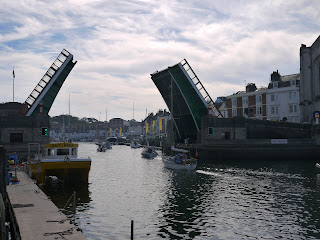 |
| Harbour Station |
My main focus for the day was to complete the section of coast path from Weymouth a m inimum of preparation work, although it looks increasingly unlikely since the local Council has asked for its removal and Network Rail have not contested the request. The ferry dock is also currently closed, while repairs to some serious structural problems are resolved. The long term future of the port must be in question after the ferry service decamped to Poole for the entire 2012 season. Nothing came of an attempt to reinstate the tramway as a transport route for the Olympics and this probably represented the last realistic chance of a revival.
I arrived on the train at Weymouth Station and it was immediately obvious that trains that had gone to meet with the ferries must have reversed out of the main station or by-passed it entirely, since the junction is just north of the throat of the platforms. This section is the only part of the entire line that is not embedded into the roadway and is pretty overgrown. With some fairly recent retail development on one side, I should imagine that retaining this narrow corridor of rail was probably quite a nuisance. It is still controlled by a colour light signal, albeit these days continually on red.
Once the tramway enters the road network it is clear that running trains along it now would be fraught with problems. The first section of road that it travels along is a very busy access road for the town centre and car parks. The idea that a train crew armed with flags could walk along in front of a train along this stretch of line seems rather ludicrous now, but that is exactly what happened until 1987 when regular passenger services finally stopped. A few railtours ventured this way in the 1990s, with the last of all in 1999. An idea of how incongruous the line would be in today's network is illustrated by an excellent film I found on You Tube from 1994
This part of the railway is probably the least interesting now, as apart from the tracks embedded in the road there is little of the original character of the line left. I crossed the road and took a look at the old 1930s bridge that would once have brought town centre traffic into Weymouth
Further down the road and the old line takes a wider curve around the harbour wall. Apparently the curve here was eased slightly back in 1938/39 to enable better rail adhesion. A set of points are still in place, although I am not sure that the second line was anything more than a siding. I suddenly became aware of how much boat movement there was in the marina as I rounded the corner as it soon became clear that the queue of boats were waiting for the lifting bridge to be opened. I am not sure if this is by demand or at a scheduled time, but clearly there were plenty wanting to get out on such a sunny day!
I watched the bridge open with a degree of fascination and the queuing boats all passed through fairly slowly in convoy fashion. I should imagine that this bridge could cause some serious hold ups – no wonder that other bridges have now been made available.
The next part of the tramway is the one most photographed from operational days. The route passes along the quayside on the narrow road in front of the former fisheries and harbour buildings, many of them now converted to other uses such as restaurants and pubs. The harbour still has something of a buzz about it though, with plenty of fishing boats still lined up. With the added dimension of the Olympics and all the decorations that came with that, I thought that the old place still looked really good.
Eventually I came upon the Harbour Station. The first part of it was a platform only on one side of the double track formation. I think this platform would originally have been used for transferring goods from ship to train, as tomatoes and other fresh produce from the Channel Islands was once brought in through this port. The main passenger station is just beyond and adjacent to the ferry terminal where cross channel ferries once left from. The only French service that has operated in recent years has been an extension of the Channel Islands service, presumably because of the difficult access for vehicular traffic. However, Condor Ferries ran a seasonal Channel Island
Whatever the future as a ferry port, the station itself has been mothballed for 25 years. Yet despite the length of time that has elapsed since the final services ran, the station itself is in remarkably good health. Maybe it is because of the sea air that suppresses weed growth, or maybe because of maintenance, but the station is still pretty weed free. It is obviously derelict though and would take some investment to get going again. How long this station will remain in this state is anybody’s guess. I would imagine that the showcasing that Weymouth got during Olympic year, inward investment may result and places like this that aren’t earning their keep must surely be ripe for redevelopment.
 |
| Goods Platform |
 |
| Olympic Decorations |









Hi Paul
ReplyDeleteLovely video, I bet that train running along the harbour surprised a few people in Weymouth.
Justs shows how inconsiderate some folks are when parking their vehicles. I would have loved to have seen their faces upon returning to find their cars gone.
Bill
http://www.walksintameside.co.uk
Thanks Bill,
DeleteIf you look around on You Tube there are other films showing much the same thing. In fact this wasn't unknown even during British Rail days. No wonder the powers that be wanted to shut it down. Definitely an anachronism!
Regards
Paul